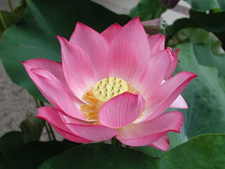anicca (impermanence): One of the common characteristics of all conditioned appearances is that they arise, pass away and cease to exist. They are all impermanent. When the fact of incessant change of all mental and physical phenomena is directly observed with mindful awareness, the mind’s door to liberating understanding opens.
anatta (not-self, impersonality): One of the three common characteristics is the fact that all experiences of mind and body arise due to the conjunction of innumerable causes and conditions, none of which have an inherent existence free of dependence upon others. There is no inherent “thing-ness” or self within any experience. This characteristic is called “not-self.” Direct observation or realization of this understanding also opens the mind’s door to liberating understanding.
dāna (generosity): One of the forces of purity (ie. non-attachment) is the open-handed offering of something of value to another being out of a sincere wish that they be happy without any other expectation. Generosity is a practice to be developed with awareness and understanding. For more information about dāna and generosity, click here.
dhamma (the truth): Dhamma has a wide range of meanings not easy to encompass in a single word. Initially it means “the way things are.” It refers to the nature of things or the truth of the way it is. Additionally, every experience is called a dhamma, ie. the way it is at that time. All physical and mental experiences are called dhammas. Finally, the Dhamma refers to the extensive teachings of the Buddha pointing out the way it is now and throughout time.
dukkha (unsatisfactoriness): One of the common characteristics of all mental and physical phenomena is the fact that they are inherently unstable. This renders them incapable of providing any security, stability, or foundation to rely on for one’s happiness. Initially, dukkha means pain: the obvious physical and mental pain that all beings suffer at times. Secondarily it refers to the fact of instability due to incessant change and the vulnerability that this imposes on one in caring for the body and mind. Thirdly, it refers to the on-going stimulation of the mind and body through the six sense doors and the burdensomeness of having to deal with the inevitable demands that the body and mind imposes on one. The Truth of Dukkha was the First Noble Truth that the Buddha pointed out in his teachings.
metta (lovingkindness): Lovingkindness is the cultivation of the sincere wish to be happy, directed towards oneself or others. It strengthens the capacity of the heart to forbear challenges patiently and to connect with all beings in any condition and situation. It is the directing of loving thoughts wishing for physical safety, mental happiness and an enduring sense of ease and well-being for oneself or others.
sati (mindfulness): Mindful awareness is the direct observation of momentarily arising mental and physical phenomena.
vipassanā (insight): Vipassana refers to the practice that refers to the refined understanding of the individual nature of the body and mind as well as the realization of the common characteristics of all experience from an intimate, direct observation of the momentary arising and passing away of physical and mental phenomena. Such insightful understanding has the power to liberate the mind from misunderstanding the nature of reality.

